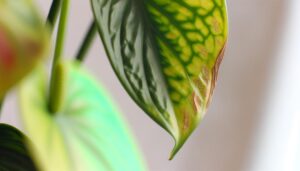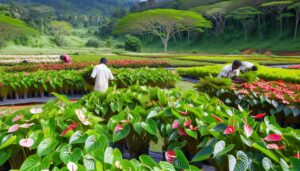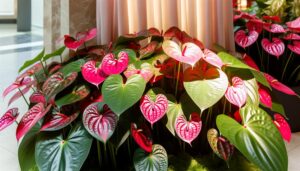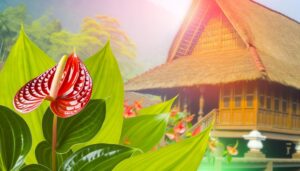Anthurium Flower Information in Sinhala: A Comprehensive Guide
If you're looking for extensive information on Anthurium flowers in Sinhala, this guide has you covered. Learn about their origin in Central and South America, valued by ancient Aztecs and Mayans.
Anthuriums like A. andraeanum and A.
scherzerianum
require bright, indirect light and high humidity (70-80%). Maintain soil pH between 5.5-6.5, and use a well-draining, peat-based mix.Water when the top inch of soil dries, and watch for pests like aphids and spider mites. Propagate through harvested seeds in a sterile, moist medium.
Dive deeper to grasp ideal growing conditions and troubleshooting tips.
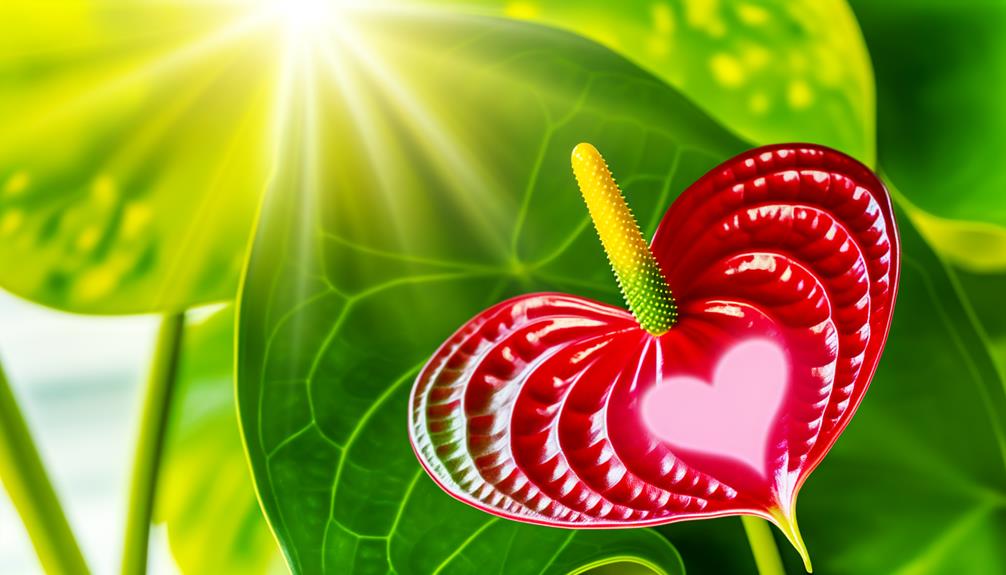
Key Takeaways
- Anthurium flowers are native to Central and South America, valued for beauty and medicinal properties by ancient civilizations.
- Popular varieties include Anthurium andraeanum, Anthurium scherzerianum, and Anthurium crystallinum, each with unique care needs.
- Ideal growing conditions: bright, indirect light, 70-85°F temperature, 70-80% humidity, well-draining peat-based soil, and pH 5.5-6.5.
- Water when the top inch of soil is dry and use a balanced 20-20-20 fertilizer diluted for feeding.
- Common issues include pests, overwatering, underwatering, and insufficient light; early detection and proper care are essential.
Origin and History
The Anthurium flower, originally native to the tropical regions of Central and South America, has a rich history that dates back to the pre-Columbian era.
You'll find that ancient civilizations like the Aztecs and Mayans valued Anthuriums for their striking beauty and medicinal properties. They utilized the plant in religious ceremonies and traditional medicine, recognizing its unique characteristics.
The flower's journey to global recognition began when European explorers brought it back to the Old World. Over time, the Anthurium adapted to various climates, which facilitated its spread.
In modern horticulture, hybridization techniques have further diversified its genetic pool. Understanding this historical context can deepen your appreciation for the Anthurium's enduring legacy in both cultural and botanical spheres.
Popular Varieties
As you explore the diversity of Anthurium flowers, you'll encounter several popular varieties that stand out for their unique shapes, vibrant colors, and specific growing requirements.
The Anthurium andraeanum, known for its heart-shaped spathes and glossy appearance, is a prominent choice. Its spathes range from deep reds to whites.
Anthurium scherzerianum features spiraled spathes and a curly spadix, often in fiery red-orange hues.
Another notable variety, Anthurium crystallinum, is prized for its large, velvety leaves adorned with striking white veining.
Each of these varieties demands tailored care, from humidity levels to soil composition. Recognizing these differences helps you select the right Anthurium for your environment, ensuring healthy growth and vibrant blooms.
Ideal Growing Conditions
To cultivate Anthurium flowers successfully, make sure they receive bright, indirect light and maintain a consistent temperature between 70-85°F. Direct sunlight can scorch the leaves, so place them near a window with filtered light.
Humidity is essential; aim for 70-80% relative humidity. You can use a humidifier or place the pot on a tray filled with water and pebbles to achieve this.
Maintain good air circulation to prevent fungal diseases. Use a well-draining, peat-based potting mix to avoid waterlogging, which can lead to root rot. Regularly check soil pH levels, keeping it slightly acidic, around 5.5 to 6.5.
These conditions will help your Anthurium thrive and produce vibrant, healthy blooms.
Watering and Feeding
To guarantee your Anthurium thrives, you must adhere to a best watering schedule that maintains soil moisture without causing waterlogging.
It's important to provide balanced fertilization, focusing on nutrients like nitrogen, phosphorus, and potassium.
Regularly monitor soil conditions and adjust watering frequency based on environmental factors.
Optimal Watering Schedule
Consistently monitor the soil moisture levels to secure your Anthurium receives sufficient watering without becoming waterlogged. You should water it when the top inch of soil feels dry to the touch. Overwatering can lead to root rot, so it's essential to strike the right balance. Use a well-draining potting mix and make sure the pot has drainage holes.
Here's a quick reference table to help you:
| Condition | Action |
|---|---|
| Top inch of soil dry | Water thoroughly |
| Soil still moist | Hold off on watering |
| Leaves wilting | Check soil and water if dry |
You can use room-temperature water to avoid shocking the roots. Regularly check the plant and adjust your watering schedule based on seasonal changes and humidity levels.
Nutrient Requirements
As you maintain the best watering timetable, it's equally important to understand the specific nutrient requirements to guarantee your Anthurium thrives.
Anthuriums need a balanced fertilizer, ideally a 20-20-20 mix, diluted to half-strength. Apply this every six to eight weeks during the growing season.
Ensure the soil pH stays between 5.5 and 6.5 for prime nutrient absorption. Over-fertilization can lead to salt buildup, damaging roots, so flush the soil with water monthly.
Pay attention to signs of nutrient deficiencies, such as yellowing leaves, which might indicate a need for micronutrients like magnesium or iron.
Common Issues
When caring for Anthurium flowers, you'll encounter common issues like pests and diseases, incorrect watering, and inadequate light.
Pests such as aphids and spider mites can cause significant damage if not promptly addressed.
Additionally, both overwatering and underwatering can lead to root rot or dehydration, while insufficient light can stunt growth and reduce blooming.
Pests and Diseases
Identifying and managing pests and diseases in Anthurium plants are essential for maintaining their health and vibrant appearance. You'll encounter various pests and diseases that can harm your plants. Regular inspection helps catch issues early. Here's a detailed breakdown of common pests and diseases:
| Problem | Symptoms |
|---|---|
| Aphids | Yellow, curling leaves |
| Mealybugs | White, cottony masses |
| Spider Mites | Webbing, stippled leaves |
| Root Rot | Wilting, brown roots |
| Bacterial Blight | Water-soaked lesions |
Effective management involves using insecticidal soap for pests, ensuring proper drainage for root rot, and removing infected leaves for bacterial blight. Consistent monitoring and prompt action are key to keeping your Anthurium healthy.
Watering Problems
Overwatering or underwatering greatly impacts the health and growth of your Anthurium, leading to symptoms such as yellowing leaves and root rot. Carefully monitor soil moisture levels to maintain ideal hydration.
Overwatering often results in soggy soil, depriving roots of oxygen and causing rot. To prevent this, make sure your pot has proper drainage and avoid letting the plant sit in water.
Conversely, underwatering leads to dry, brittle leaves and stunted growth. Check soil moisture by feeling the top inch; it should be slightly arid before watering. Use a well-draining potting mix to balance water retention and drainage.
Consistent watering practices, tailored to seasonal changes, will help maintain the health and vibrancy of your Anthurium.
Light Requirements
Proper watering practices are crucial, but understanding the light needs for your Anthurium is equally important to guarantee robust growth and vibrant blooms. Anthuriums thrive in bright, indirect light. Direct sunlight can scorch their leaves, leading to browning and reduced vitality. Insufficient light, on the other hand, can cause leggy growth and fewer flowers.
To ensure optimal light conditions:
- Place your Anthurium near an east or north-facing window where it gets filtered light.
- Use sheer curtains to soften intense sunlight.
- Rotate the plant periodically to ensure even light exposure on all sides.
- Supplement with artificial lights during darker months or in low-light environments.
- Monitor leaf color and growth; pale leaves suggest too much light, while dark, leggy growth indicates too little.
Understanding these light requirements will keep your Anthurium healthy and vibrant.
Propagation Techniques
To effectively propagate Anthurium flowers, you should utilize techniques such as division, stem cuttings, and seed germination, ensuring you adhere to specific guidelines for each method.
For division, carefully separate the root clumps during repotting, making sure each section has roots and leaves.
Stem cuttings require selecting healthy stems with at least two nodes, cutting just below a node, and planting in a well-draining medium.
Seed germination involves harvesting ripe seeds, cleaning them, and planting in a moist, sterile medium. Maintain a warm, humid environment to facilitate growth.
Each method demands attention to detail, from the health of the parent plant to the conditions of the propagation medium, ensuring successful propagation and development of robust Anthurium plants.
Conclusion
In your quest to master anthurium cultivation, you've discovered secrets that rival ancient horticultural wisdom. By understanding its history, selecting the perfect variety, and optimizing growing conditions, you're not just a gardener—you're a plant whisperer.
Your careful watering, feeding, and problem-solving skills will guarantee your anthuriums bloom like never before. And with accurate propagation techniques, you'll have anthuriums multiplying faster than you can say “botanical wonder.”
Your garden will be the envy of enthusiasts everywhere!

